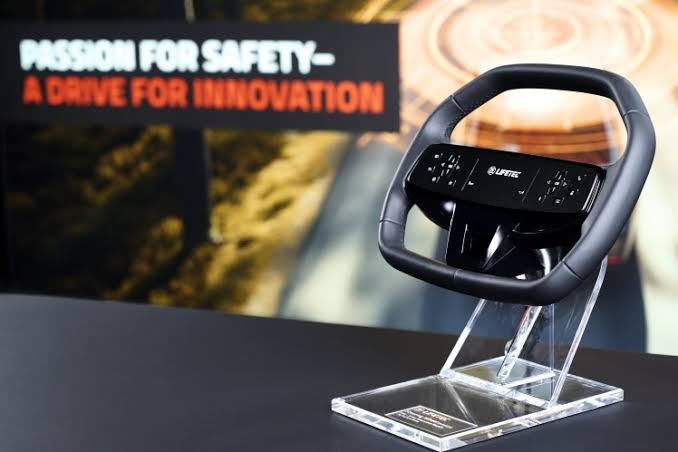Nearly 47% of the global airbag market belongs to just one company, Autoliv. But German automotive giant ZF just shook up this $16+ billion industry with a revolutionary design that's turning decades of safety engineering upside down.
The conventional airbag has sat in the center of every steering wheel since the technology's widespread adoption in the 1990s. ZF Lifetec changed that in June 2024 with their groundbreaking top-deployment system. Instead of inflating from the wheel's center, their innovative airbag deploys from the top rim, creating unprecedented design freedom for automakers.
The Engineering Breakthrough That Changes Everything
I've been following passive safety systems for sometime, and this represents the most significant steering wheel innovation since electronic stability control integration. ZF's top-deployment airbag maintains full safety protection while freeing up the steering wheel's central hub, the prime real estate that designers have coveted for years.
The technical achievement here is remarkable. Traditional airbags require substantial space behind the steering wheel hub for the inflator and folded bag assembly. ZF's engineers relocated this entire system to the wheel's upper rim, deploying the airbag downward toward the driver's chest during impact.
This isn't just clever packaging, it's a complete reimagining of crash protection geometry. The airbag still provides the same protective surface area and deployment timing, but the mechanism fundamentally changes how we can design vehicle interiors.
What This Means for Your Next Car
The immediate beneficiaries are automotive interior designers who can now integrate screens, touch, sensitive controls, and advanced haptic feedback systems directly into the steering wheel center. Think smartphone-like functionality where the horn buttons once lived.
ZF demonstrated prototypes featuring seamless black panels with integrated force-sensitive controls. These aren't concept car fantasies, this is production-ready technology that passed rigorous safety testing.
More significantly for the driving experience, this opens the door to adaptive steering wheels that change function based on driving modes. Manual driving could display traditional controls, while autonomous mode transforms the center into an entertainment or productivity interface.
The Market Reality Check
Here's where my professional experience becomes crucial, understanding the gap between innovation and implementation. ZF commands approximately 20% of the global passive safety market, making them the second largest supplier after Autoliv's dominant 47% share. ZF's press release confirms their €4.6 billion in 2023 sales and relationships with virtually every major automaker.
However, ZF hasn't announced production timelines or confirmed which manufacturers will first adopt this technology. In my experience, revolutionary safety innovations typically require 2 - 4 years from demonstration to mass production due to extensive validation requirements.
The global automotive airbag market, valued at $16.33 billion in 2024, is projected to reach $27.74 billion by 2032. ZF's innovation positions them to capture significant additional market share as automakers seek differentiation through interior design.
Safety Implications You Need to Know
The critical question every automotive professional asks: does relocating the airbag compromise protection? ZF's engineering data suggests no safety reduction, but this represents their internal testing, independent validation by regulatory bodies hasn't been published yet.
What impresses me is ZF's dual contour airbag development alongside this innovation. This complementary technology protects drivers in both standard seating and reclined comfort positions, essential for autonomous vehicles where occupants may not maintain traditional driving postures.
The company also introduced internal side airbags that deploy before impact, creating additional crumple zones. This demonstrates ZF's comprehensive approach to next-generation safety, not just steering wheel aesthetics.
This innovation signals a broader shift in automotive interior philosophy. As vehicles transition toward autonomous capabilities, the steering wheel's role evolves from pure control interface to multifunctional user experience hub.
ZF's timing is strategic. The company recently spun off its passive safety division as ZF Lifetec, providing focused resources for innovations like this. Their global presence, 48 locations across 20 countries with 36,000 employees, ensures rapid scaling once production begins.
For repair professionals, this technology will eventually require new diagnostic procedures and replacement protocols. The top-deployment mechanism likely involves different sensor integration and deployment algorithms compared to traditional center-hub systems.
What's Next?
While ZF hasn't announced specific production partnerships, their established relationships with major OEMs suggest rapid adoption once regulatory approvals complete. Given the automotive industry's current focus on interior innovation and autonomous vehicle preparation, this technology addresses market demands perfectly.
The real question isn't whether this innovation will reach production, it's which automaker will first leverage this competitive advantage. In an industry where interior differentiation increasingly drives purchase decisions, ZF's airbag breakthrough offers genuine value beyond mere novelty.
For automotive professionals monitoring industry trends, ZF's top-deployment airbag represents more than clever engineering, it's a glimpse into how safety innovation continues enabling the next generation of vehicle experiences.

Comments (0)
Please login to join the discussion
Be the first to comment on this article!
Share your thoughts and start the discussion